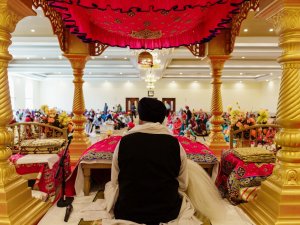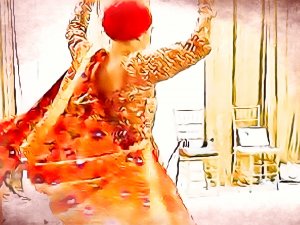Content Warnings: Extreme caste violence and gender violence
Casteism Still Plagues Sikh Communities
While most of the protestors at the Delhi farmers protests come from the jat caste, we must understand that this struggle affects people from all castes. Those from oppressed castes often find it more difficult to fight for their rights as they find their intersectional identities make them more vulnerable to discrimination and opposition.
The Sikh Gurus challenged casteism and brahmanism–which is loosely defined as a socio-religious ideology which serves the interests of the brahmin caste and its allies. Brahmanism engages in and perpetuates the process of human degradation through systems of privilege and punishments for upholding their preferred social order (Jagjit Singh). At Kaur Life, we believe we should continue the Gurus’ work of dismantling caste and disavowing caste privileged. We can use Sikhi as a lens and as an orientation to battle injustices and caste dominance. But we can only do so by first understanding the plight of people from oppressed caste backgrounds.
As we see in Gurbani:
ਗਲੀ ਜੋਗੁ ਨ ਹੋਈ ॥ ਏਕ ਦ੍ਰਿਸਟਿ ਕਰਿ ਸਮਸਰਿ ਜਾਣੈ ਜੋਗੀ ਕਹੀਐ ਸੋਈ ॥੧॥ ਰਹਾਉ ॥
Religion does not consist in words, only one who looks on all people as equal is religious.
And Guru Amar Das Sahib Ji (Raag Bhairao, Ang 1127):
ਜਾਤਿ ਕਾ ਗਰਬੁ ਨ ਕਰਿ ਮੂਰਖ ਗਵਾਰਾ ॥ ਇਸੁ ਗਰਬ ਤੇ ਚਲਹਿ ਬਹੁਤੁ ਵਿਕਾਰਾ ॥੧॥ ਰਹਾਉ ॥
Do not be proud of your social class and status, you ignorant fool! So much sin and corruption comes from this pride.
Guru Nanak Sahib Ji (Raag Sohee, Ang 730)
In the spirit of these shabads revealed to our Gurus, we share with you Shreya Sharma’s interview with Punjabi Dalit women fighting for their farming rights at the Delhi Borders.
Denying Dalit Land Use
At the Tikri Border, student activists of the Punjab Students’ Union have been protesting for the last three months against the new farm bills. The first time I met them was by chance, when I’d gone to interview a member-leader of Zameen Prapti Sangharsh Committee (ZPSC) (which translate to The Struggle to Obtain Land Committee) to document the struggles of landless Dalit farmers in the villages of Punjab – where 32% of people are Dalit. The ZPSC consists of eight organisations and began in 2014 after years of Dalits being denied the right to acquire village common land, referred to as shamlat land, for cultivation purposes. The Punjab Village Common Lands Regulation Act of 1961 provides for the reservation of 1/3 of village common land that is annually leased to them. However, very few Dalits end up acquiring land due to malpractices such as proxy buyers set up by zamindars (landowners) in auctions and unaffordable high lease costs that make it difficult to hold onto the land. Furthermore, some shamlat land is being sold for development. Organizations like ZPSC have mobilised support in various villages in Punjab and built co-operative farming techniques for sustainable and equitable distribution of land among Dalit farmers.
The organization has conducted awareness campaigns in villages to mobilise support and create awareness that such a right exists, as many still don’t know of their legal right to own or lease land and are caught in endless cycles of upper caste oppression; often having their lands hijacked for the smallest of debts, living in fear of village-wide boycotts for demanding a fair wage, expressing grievances, and of women’s safety who go to work in these fields. Members and their families have been martyred in battles led by ZPSC that erupted upon assertion of their rights.
Interviewing Dalit Young Women
After my interview with the ZPSC, I spoke to some women – Sukhpreet Kaur (22), Kamaldeep Kaur (19) and Kiranjeet Kaur (24) seated in the same tent, earnestly engaged and curious about my purpose. We ended up chatting for two hours during which they shared why they are here, what perpetuates caste violence, the struggles Dalit women face back in villages of Punjab, and the role they are playing in this rapidly growing movement in Punjab for land rights. Below are some excerpts from the conversations.
What do you think of the farmers protests?
These protests are being hailed as a “Kisan Morcha” which mostly refers to upper caste/jat farmers/ but it’s not just about these kisan (farmers). This affects everyone. We come from a landless labour family, and most labourers’ livelihoods depend on working on these farms. The new laws make changes like imposing stock limits [The Essential Commodities Act Amendment] and do away with electricity waivers [Electricity Amendment 2020] which affect us all.
If you look at it, very few Dalit families have come out in protest. This is because active participation and claiming our rights often leads to village-wide boycotts by the upper caste [against hiring, working with, or interacting with Dalits], and even killings or mob violence. At home it is very normal for our families to tell us not to talk about our grievances or demand fair wages for fear of consequences from the zamindars and upper caste villagers. At the same time, some people think they will be unaffected by these changes; instead of the upper caste zamindar, now the exploitation will continue in a factory. So, they think not much is going to change for them anyway, and do not empathise with the zamindars. Why would they?
What issues do women face back in villages?
Oftentimes women go to get food for their cattle, they face casteist slurs and very vulgar language. There is physical assault, harassment for the smallest of things. Women do double the work that men do, they take care of homes and work on the fields yet they are paid less than men. If a man gets 300 rupees for mazdoori (labor), a woman will get 200 rupees in a day. Avoiding harassment isn’t an option when you don’t own land and need food for cattle that comes from land which is for common use. Landlessness continues to be the root cause of casteism in villages and perpetuates the cycle. About 5% of Dalits tend to own land in the Punjab, which has the highest population of Dalit farmers. Zamindars think Dalits are there to serve them and so our assertion of rights leads to more violence. That is why the movement for land rights led by ZPSC began. ZPSC – mobilised by Dalit farmers empowers others Dalit farmers to reclaim and cultivate their own land. It has ensured us some financial autonomy and dignity in breaking away from the monopoly the “ruling class” has established over land. While the legal provision for reservation of shamlat land for Dalits was always there, deep prejudice and entitlement in the so called “upper caste” members who are present at all levels in society – whether state machinery or local police, has made it defunct. Acquiring land rights is a big step that way.
What roles have women taken up in the ZPSC? Do any Sikh women inspire you?
Many women have been at the forefront of battles led by ZPSC. We get inspired by their resilience every day which we feel is in us too. Men are often more easily targeted and killed, and to prevent that from happening women in villages have hid them in jute bags inside their homes [during times of heightened caste violence]. In October 2016, Dalits from Jaloor village of Sangrur in Punjab staged protests demanding their share in the village common land and faced severe repression from landlords in response. While going back to their village from a protest rally the landlords, with the help of local police and leaders, attacked protestors and injured many. The zamindars tried to humiliate and intimidate the women with obscene gestures, nudity, in an effort to scare them off; however the women stayed. They resisted. All the violence happened under police watch. It was amidst this violence, that the goons attacked one of our leader Balwinder Singh’s (Jhaloor village, Sangrur District) mother, Gurdev Kaur, who eventually succumbed to her injuries [and died]. While they succeeded in obtaining the land as a result of this struggle, till today the FIR [police report] is not registered against those accused and many perpetrators continue to roam free. We still remember dadi every year [and this] Battle of Sangrur and get together to mourn the loss and demand justice.
Women activists in our union like Hardeep Kaur Kotla, who had to leave her home due to opposition from her family towards her activism also continue to inspire us. Historically, Mai Bhago and Gadri Gulab Kaur, a freedom fighter from Sangrur who left her husband and the prospect of a safe life in the West to join the Ghadar movement and fight the British often come to mind.
What do you think is the situation of our state today and where do you think we are headed?
Today, we see an attack on our education, and our right to dissent. Colleges are being privatised and this reduces options for many. Just the way they are going about the agricultural sector right now, the same way our right to education is also being stifled. It has become so easy to be labelled as a deshdrohi (terrorist) or anti-national; if speaking up against oppression and for your rights is being anti-national, then yes, we are anti-national. We look at our professors who are also carrying out protests and fighting for their jobs, and our professors are people who empower us but seeing them struggle, we wonder – what possibilities do we have of a bright future? How do we even hope we will have one? The only option left then is to fight to abolish this system that upholds systemic oppression through casteism, capitalism, monopoly of economic resources in the hands of a few, and create an equal society. They have slowly cut off all our options and this is the strategy used to target anyone who dissents.
One of the professors present there, Jagroop Kaur, joins the conversation as we talk of stifling dissent.
Why is it that if you are from Kashmir, then you’re labelled an aatankwadi (terrorist) and if you are from Punjab, then the term coined is Khalistani. When a Hindu chants Ram’s name, that is never an issue then why is it that when a Sikh chants, “Jo bole so nihal sasriakal,” then it is given a communal colour and they are painted as separatists? What they are trying to do is divide people on the basis of religion for votes.
She goes on to add what many of her Kashmiri students at Baba Farid University struggled with during the COVID19 lockdown:
At Baba Farid University of Health Sciences where I teach, students from Kashmir went home during the lockdown and the college decided to conduct online exams. Now, with no internet connection, how will they sit for exams? They had to protest for seven days after which exams were postponed. So, when you talk about access in this sense, many students from Dalit and other backgrounds don’t have android phones, so what is the point of having online education? There are many, many such small things that tell of very big problems.
As the sun set, our conversations faded to lighter notes with a warm invitation to share dinner and a birthday celebration with them.
“Stay the night today, we have music programs and lots of conversations post dinner.”
We encourage our readers to read more about Dalit rights activism and to ways to work towards ending casteism. One way to start is by checking out Manu and manmit’s article, “When Will Caste-Oppressed and Queer and Trans Folks Find Liberation in Sikh Spaces“.
About the Author
Shreya is a writer and aspiring photographer based in Delhi. She recently completed her degree in law and worked as a reporter with The Hindu in Mumbai before becoming a freelancer to pursue her new-born, ever changing creative callings. You can find some of her documentary work on the farmer protests on her Instagram: shhreya.sharma





